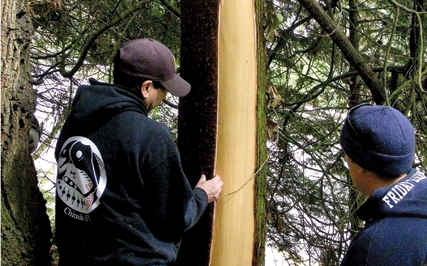Culture
Tribe receives trees, bark from Sellwood Bridge project

The successful partnerships that the Tribe has built in the Portland metropolitan area paid surprise dividends in mid-April when cedar bark and yew trees from the renovation of the Sellwood Bridge were given to the Grand Ronde people for future cultural use.
"Through partnerships with Multnomah and Clackamas counties and the city of Portland, we've done an exemplary job of reminding stakeholders that they're in the ceded lands of the Grand Ronde people," said Siobhan Taylor, the Tribe's Public Affairs director, who first received word that the cultural resources could be made available to Tribal members.
"As a result of these efforts, they let us know when they have projects that might affect the Tribe," Taylor said.
Some 800 trees are being taken down in the Sellwood Bridge project.
"There's been coordination with the Grand Ronde Tribe and others in the valley for about a year," said Multnomah County spokesman Mike Pullen. "When the Sellwood Bridge project began, we thought about how we could work together."
The connection came through Kevin Kilduff from the Portland office of Healthy Working Rivers, who put the county in touch with Tribal member and Tribal consultant Greg Archuleta, who works out of the Tribe's Portland office on Barbur Boulevard.
Initial concerns centered on whether Native artifacts or burial sites would be found, said Pullen, but when the arborist catalogued trees in the area, it became clear that bark from cedar trees and the wood from yew trees in the area could be used as cultural resources.
"The bark will be used for a variety of projects within our lifeways and culture classes," said Archuleta. Although the materials are being stored at the Portland Tribal office, Archuleta said that they will share with Tribal Elders and members in other locales.
Archuleta, and Tribal members Jon George, his son, Trey, Jade Unger and Eric Bernando collected the cedar bark and yew trees on Sunday, April 15.
The bark and yew wood set for a year before they are used, Archuleta said. "Then we can use the bark for basketry, cedar mats, hats, cordage and rope making, and we might be able to do some traditional cedar clothing."
Yew trees can be used for digging sticks, like digging camas, for adze handles, for bow making and other carving projects, Archuleta said.
"It was a great opportunity to have a partnership with Multnomah County to secure the trees," he said.
"I've worked for the county for 14 years," said Pullen, "and this is first time we've cut more than a couple trees. It doesn't come up very often, but it's been a real positive experience, and we would love to do it again if the opportunity comes up."
A similar possibility has already come up through Tri-Met, Archuleta said, which is building a new line to Milwaukie. And more trees may yet become available from the Sellwood Bridge project.
